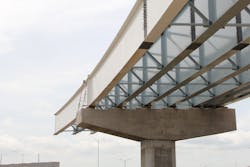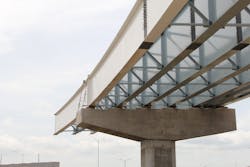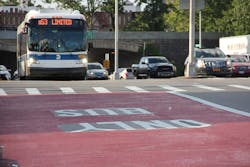A bright horizon
The increase in green bike lanes around NYC is reflective of the city’s goals for its Vision Zero traffic safety initiative.
New York City is world-renowned for many reasons, and perhaps one of its most iconic aspects is the network of transit systems that make the city run. Yet maintaining over a century of dense transit in one of the world’s largest cities is a daunting task that the Metropolitan Transportation Authority (MTA) and the New York City Department of Transportation (NYCDOT) have to contend with daily, not to mention implementing new infrastructure and specifications. To top it all off, many of NYC’s tourist attractions are, in fact, the transit ways themselves—from the Brooklyn Bridge to streets made famous by the movies to the famed subways. This means preservation of these transportation modes as landmarks also is paramount.
Adapting to new circumstances
With the White House now proposing a $200 billion budget over a 10-year effort to go towards transportation infrastructure (bye-bye to Trump’s Trillion), many U.S. cities are recalculating their transportation budgets, and New York is no exception. The tri-state metropolitan region is home to 22.6 million residents, with 10.4 million jobs across a mere 12,800 sq miles. The city, with two busy islands within the five boroughs, has had to re-haul many central roadways, bridges and tunnels. In the 2017 New York State Department of Transportation budget, the Executive Budget Committee recommended $4.5 billion in transit aid. Since the budget is extremely limited, given the expanse of city transit, the city is now focusing on preservation, in addition to maintenance, safety and infrastructure remodeling.
In recent years, infrastructure remodeling has taken center stage for NYC officials—2008 alone saw NYCDOT beginning to take steps towards standardizing the complete streets model with the release of “Sustainable Streets: A Strategic Plan for the New York City Department of Transportation 2008 and Beyond.” In this plan not only were specific transportation infrastructure goals laid out for all five city boroughs, but budgeting commitments were made as well. The plan ambitiously promised to “reduce by half the number of traffic deaths by 2030,” in addition to stating the city’s intention to “ensure completion of . . . the 1,800 bicycle master plan and install 5,000 new CityRacks by 2011.”
Former NYCDOT commissioner Janet Sadik-Khan, who has subsequently become a leading voice in the world of urban transportation policy, set into motion many infrastructure and redesign initiatives. Her tenure saw the implementation of almost 400 miles of bike lanes as well as the launch of the Citi Bike program. Continuing with this theme, in 2011 New York Gov. Andrew Cuomo signed the 2011 Complete Streets Act. This initiative requires “state, county and local agencies to consider the convenience and mobility of all users when developing transportation projects that receive state and federal funding.” This law is to be applied to all projects that are overseen or implemented by NYCDOT, as well as any other projects that receive state funding. That would include bridge building, tunnels, roads and rails.
More recently, in 2014, Polly Trottenberg was appointed NYCDOT Commissioner. Since her appointment she has lead the city’s Vision Zero traffic safety initiative—yet she also inherited a crumbling infrastructure resulting predominantly from the damage caused by Hurricane Sandy. Her mission has “prioritized the expansion of street resurfacing and reconstruction, bridge rehabilitation and construction, improvement of bus system performance on city streets, building a cycling network of over 1,000 miles and doubling the country’s largest bike share program.”
The current priorities for transportation authorities can be broken down into one of two areas: multi-user infrastructure implementation, and rehabilitation and preservation.
Multi-user infrastructure implementation
Special-use lanes are one of the focal points of NYC’s infrastructure implementation, as the designation of these lanes has reduced vehicle incursions by 30-50% in other cities. The success in decreasing the incursion rate is aided by the application of fully colored dedicated-use lanes. Not only does this ensure visibility from all travelers, but assures understanding of that lane’s use instantaneously upon seeing the designated color, thereby increasing traffic calming and minimizing conflicts between different road users. As part of these efforts to standardize bike lane structure, the Federal Highway Administration (FHWA), American Association of State Highway & Transportation Officials (AASHTO) and the American Traffic Safety Services Association (ATSSA) are working on creating and instituting guidelines and regulations on proper lane and infrastructure implementation. Bike Lane Green is currently the only informally agreed-upon color: A green specified by an x,y coordinate color box. NYCDOT has designated specification: “Item 601.04010004 –Green Colored Surface Treatment for Bicycle Facilities.” Although yet to be standardized, bus lanes are most often red (as shown) and pedestrian areas are from a buff color to a caramel brown color.
The concept of bike lanes alone is not only still being fully understood, but also is now becoming accepted as an absolute must within complete streets infrastructure. The increase in green bike lanes around the city is in line with Vision Zero and decreasing the citywide speed limit to 25 mph. The National Association of Transportation Officials (NACTO) has specifically created the Urban Bikeway Design Guide to answer the growing amount of questions and implementation queries. This guide has become a key resource to transportation agencies across the country as they implement bike lanes. Perhaps most importantly, it breaks down the requirements from the FHWA and recommendations for durable material use such as methyl methacrylate (MMA) pavement markings.
While exact materials are not yet officially required, international cities have been using MMA materials on bike, bus and pedestrian lanes as a standard for over 50 years. NYC is beginning to implement MMA lanes with products such as Color-Safe MMA. MMA is a resin composition capable of full cure in a wide range of temperatures and, with the appropriate aggregate mixed in, creates a pigmented surface that exhibits excellent durability. Paint and other non-MMA surface coatings, which wear off or delaminate quickly and thus compromise safety, are a maintenance nightmare for cities and towns. Other materials such as thermoplastic traffic paint require frequent maintenance due to high wear, cracking and delamination, or, even more costly, need to be completely removed in order to be replaced. MMA lasts five to 10 years and retains a bold color throughout due to its excellent UV resistance. Extended life cycle of the markings means agencies can use the funds saved from using Color-Safe MMA towards other budgeting goals and can allocate manpower elsewhere as well.
Bus lanes are being re-evaluated and prioritized within the city’s infrastructure. NYCDOT defines bus rapid transit (BRT) as “a cost-effective approach to transit service that cities around the world have used to make riding the bus more like riding the subway.” To this end, they have set Select Bus Service (SBS) as the NYC version of BRT, which offers unique features, such as free subway connection, traffic-signal priority and express services, to make it as easy and user-friendly as possible. Within the SBS system NYCDOT has defined two types of bus lanes: Curbside Bus Lanes, used solely for buses that are next to the curb and are usually connecting to bus stops and stations, and Offset Bus Lanes, which are traveling lanes for buses set one lane away from the curb to allow for bike lanes, or parking or pedestrian areas. Here too, when clear and durable markings are needed, MMA products such as Color-Safe are ideal.
The Citi Bikes implementation continues through the boroughs as well, with plans to add stations in Staten Island. Bike stations not only reduce traffic, but also help keep fuel emissions low and fit in harmoniously with the complete streets model. The increase in these stations, however, does carry the need for instituting bike lanes even on bridges connecting to Manhattan.
Rehabilitation & preservation
In 2012, Hurricane Sandy did enough damage to require massive rehabilitation projects, with estimated completion in 2018. Looking to fortify the city against future weather and other emergencies, city officials have begun opting for materials that both repair and offer long-term durability.
In both the Queens Midtown Tunnel and the Brooklyn Battery tunnel, the MTA is working to fix the damage done and installing new preventive measures to ensure such damage does not occur again. One of the measures has been to revisit the tunnel’s transportation infrastructure, and so the MTA has opted to use the Visi-Barrier Precast Polymer Concrete Barrier Panel at the bench walls and catwalks in both tunnels. The panels have a unique ability to be precast offsite in configurations that incorporate air flue openings, wayfinding lights and custom lengths, which has helped to keep both tunnel projects on schedule. This choice was made not only to enhance visibility, but also due to Visi-Barrier’s ability to resist both corrosion and vehicular impacts.
Rehabilitation and preservation projects extend well beyond the city streets, bridges and tunnels to even the city airports, notably LaGuardia where extensive maintenance and renovations have been ongoing for more than a year. The $4 billion project is not only unifying all of LaGuardia’s terminals, but seeks to find long-term solutions for much of the consistent need for repairs in the airport’s transportation infrastructure. One area of focus is the runway pavement where Transpo MMA patching material and epoxy overlay are being used. Both of these materials protect and preserve the runway, thus ensuring lasting safety with a high-friction, wear-resistant and waterproof surface.
Bus lanes are being re-evaluated and prioritized within NYC’s infrastructure, with NYCDOT defining two types of bus lanes within the SBS system: Curbside Bus Lanes and Offset Bus Lanes.
Future planning
These renovations and work are truly only the beginning. Thanks to the efforts from the MTA, NYCDOT, both the New York and New Jersey Port Authority and other agencies, NYC is focused on maintenance, preservation and infrastructure improvements which will allow it to become an example of a successful complete street infrastructure. There are still other projects worth noting that make the future look even brighter, with a new proposed Hudson River tunnel, as well as extensions to subway lines, in the planning. Major universities and urban planning organizations also have their sights set on using NYC’s efforts as an example of how to maximize and improve urban infrastructure. The George Washington School of Business released “The WalkUP Wake-Up Call: New York” analysis this year, not only laying out sustainability projections, but also highlighting the transportation and urban infrastructure issues.
At present, the vision of making NYC’s complex infrastructure safe and sustainable is in the works, and though it will take time, the horizon is looking bright.
-------------
About the author: Grossman is a marketing manager for Transpo Industries Inc.


